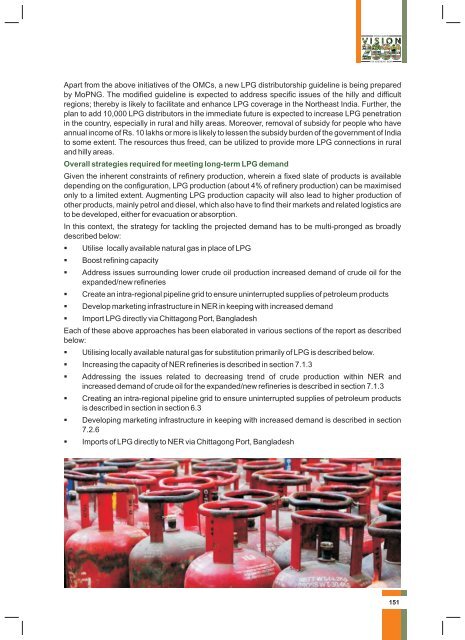Hydrocarbon Vision 2030 (ஹைட்ரோகார்பன் தொலைநோக்கு ஆவணம் 2030)
You also want an ePaper? Increase the reach of your titles
YUMPU automatically turns print PDFs into web optimized ePapers that Google loves.
Apart from the above initiatives of the OMCs, a new LPG distributorship guideline is being prepared<br />
by MoPNG. The modified guideline is expected to address specific issues of the hilly and difficult<br />
regions; thereby is likely to facilitate and enhance LPG coverage in the Northeast India. Further, the<br />
plan to add 10,000 LPG distributors in the immediate future is expected to increase LPG penetration<br />
in the country, especially in rural and hilly areas. Moreover, removal of subsidy for people who have<br />
annual income of Rs. 10 lakhs or more is likely to lessen the subsidy burden of the government of India<br />
to some extent. The resources thus freed, can be utilized to provide more LPG connections in rural<br />
and hilly areas.<br />
Overall strategies required for meeting long-term LPG demand<br />
Given the inherent constraints of refinery production, wherein a fixed slate of products is available<br />
depending on the configuration, LPG production (about 4% of refinery production) can be maximised<br />
only to a limited extent. Augmenting LPG production capacity will also lead to higher production of<br />
other products, mainly petrol and diesel, which also have to find their markets and related logistics are<br />
to be developed, either for evacuation or absorption.<br />
In this context, the strategy for tackling the projected demand has to be multi-pronged as broadly<br />
described below:<br />
Utilise locally available natural gas in place of LPG<br />
Boost refining capacity<br />
Address issues surrounding lower crude oil production increased demand of crude oil for the<br />
expanded/new refineries<br />
Create an intra-regional pipeline grid to ensure uninterrupted supplies of petroleum products<br />
Develop marketing infrastructure in NER in keeping with increased demand<br />
Import LPG directly via Chittagong Port, Bangladesh<br />
Each of these above approaches has been elaborated in various sections of the report as described<br />
below:<br />
Utilising locally available natural gas for substitution primarily of LPG is described below.<br />
Increasing the capacity of NER refineries is described in section 7.1.3<br />
Addressing the issues related to decreasing trend of crude production within NER and<br />
increased demand of crude oil for the expanded/new refineries is described in section 7.1.3<br />
Creating an intra-regional pipeline grid to ensure uninterrupted supplies of petroleum products<br />
is described in section in section 6.3<br />
Developing marketing infrastructure in keeping with increased demand is described in section<br />
7.2.6<br />
Imports of LPG directly to NER via Chittagong Port, Bangladesh<br />
151

















